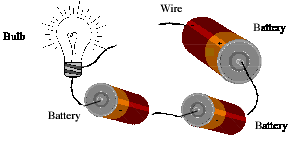TRB 5:4 - Activity 5: Conductors vs. Insulators
Summary
Through hands-on activities students will first predict which objects will conduct electricity and then they will test their predictions.
Materials
- at least 3 fresh D--size batteries
- wire
- flashlight size bulb
- Kit #1 from previous lessons
Additional Resources:
Electricity by TOPS Learning Systems
10970 S. Mulino Road
Canby, OR, 97013
Student Resource Books:
Electricity
Electronic Communication
Science Experiments with Electricity
Grolier Classroom Publishing
Children 's Press, Franklin Watts
90 Sherman Turnpike
Danbury, CT, 06815
(800) 621-1115 FAX (800) 374-4329
Background for Teachers
Solids, liquids, and gases can be conductors. Some items students may test are conductors, but do not conduct enough electricity to make the light bulb's filament glow.
Intended Learning Outcomes
1-Use science process and thinking skills.
3-Understand science concepts and principles.
Instructional Procedures
Attachments
-
image35.gif
-
insulators.pdf
Insulators and Conductors Data Sheet
Invitation to Learn:
Does anyone know what the wires are made of that carry electricity through our
school? Why is copper a good choice? What do those wires look like?
Instructional Procedures:
- .Assemble a circuit with the three batteries and bulb. Disconnect the wire
attaching the bulb to one of the batteries. Add an extra wire on the bulb
side of the gap. These two side-by-side wires will act like a switch. When
the ends of the wires touch the bulb should light.

- Take the penny out of the bag. Make a written prediction of whether it will conduct enough electricity to light the bulb. Using the two wires we just arranged, touch one to each side of the penny. The bulb should still light. The penny conducts electricity.
- Take out the plastic spoon. Make a written prediction of whether it will conduct enough electricity that the bulb will light. Place one of those wires on each end of the plastic spoon. The wires should not touch each other; the spoon should be between them. The bulb should not light. The spoon is an insulator.
- Continue to make predictions and to test the remainder of the items in the bag.
- Allow students to try various items including items in their own desks.
- Make a generalization about the types of materials that conducted enough electricity for the bulb to light.
- Complete the "Conductor/Insulator " data sheet.
Extensions
- Remove most, if not all conductors from bags and put in one mini-size Kit Kat bar, a bulb, and a battery. Return to students with the challenge to light the bulb using only the items in the bag. The foil-coated inner wrapper will make a good wire to conduct the electricity.
- Adapt this lesson by changing the bagged items for cups of liquids. Salt
water is an excellent conductor. Baking soda dissolved in water and sports
drinks, like Gatorade, are also fairly good conductors. Tomato juice works
well due to the high salt content. Many other household liquids will conduct
electricity, but not enough to allow the bulb to light. You will probably
need to use more than 5 D-size batteries to get visible results with liquids
other than salt water.
Assessment Plan
Write a list of conductors and insulators in your science journal. Homework: Make a list of conductors and insulators you find in your bedroom.
Bibliography
This lesson is part of the Fifth Grade Science Teacher Resource Book (TRB3) http://www.usoe.org/curr/science/core/5th/TRB5/. The TRB3 is designed to be your textbook in teaching science curriculum to your students. This book covers all the objectives of each standard and benchmark. If taught efficiently, a student should do well on the End-of-Level (CRT) tests. The TRB3 is designed for teachers who know very little about science, as well as for teachers who have a broad understanding of science.
Updated: 10/10/2022


 UTAH EDUCATION NETWORK
UTAH EDUCATION NETWORK

 Justin
Justin Braxton
Braxton Dani
Dani Kayla
Kayla Katie
Katie Matthew
Matthew Rob
Rob Val
Val
